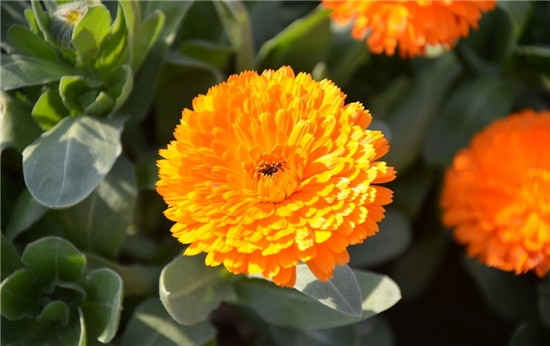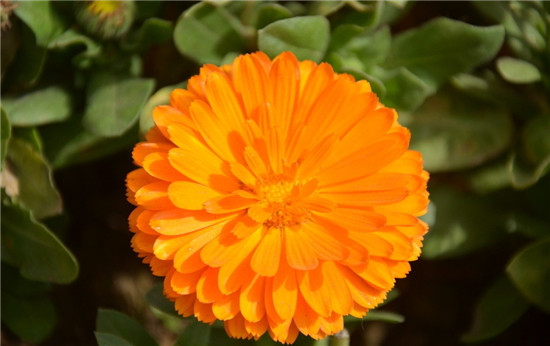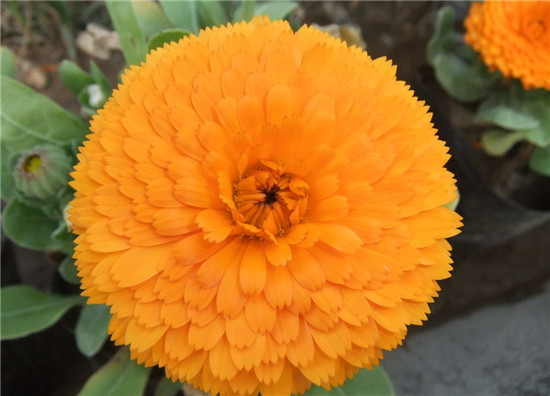Life habits and planting of Calendula
Calendula, also known as calendula, is an annual or biennial herb with edible leaves and petals native to southern Europe. Next, let's take a look at the living habits and cultivation of marigold flowers.

Calendula was used medicinally or as a dye in the ancient West, as a cosmetic or as an edible, edible leaf and petal, and as an ornament in dishes. Originated in Southern Europe. it has medicinal value of anti-inflammatory, antibacterial, clearing away heat, reduce fire, and treating acne. Calendula of the compositae family. Annual or more annual herbs, like light, soil requirements are not strict, can grow well in dry, loose fertile alkaline soil, barren resistance, often used for flower beds. Calendula is rich in a variety of vitamins, especially vitamin A and vitamin C; almost all parts can be eaten; its petals have beauty functions, flowers contain carotenoids, tomato hydrocarbons, butterfly plum, rubin, volatile oil, resin, mucus, malic acid and so on.
Calendula plant height of 30-60cm, for biennial herbs, the whole plant is white velutinous. Leaves simple, alternate, elliptic or elliptic-obovate, entire, basal leaves stipitate, upper leaf base clasping.

capitulum solitary on top of stem, large in shape, 4- 6 cm, ligulate flowers in a whorl, or in multiple whorls spreading, golden yellow or orange, tubular flowers, yellow or brown. There are also double petals (actually multi-layered ligulate flowers), rolled petals and green hearts, dark purple flowers and other cultivated varieties. The flowering period is from December to June, and the full flowering period is from March to June. Achene, boat shape, claw shape, fruiting period 5-7 months.
Like sunny environment, adaptability is strong, resistance-9℃ low temperature, afraid of hot weather. Do not choose soil, loose, fertile, slightly acidic soil is best, self-sowing, fast growth, more cold-resistant, do not choose soil. Resistant to barren dry soil and cool environment, in the sun and fertile areas grow well.
Calendula is native to western Europe, the Mediterranean coast, North Africa and West Asia and is cultivated all over the world. Thompson Morgan in England and Danzij Flowers in Israel are well known in Europe for the breeding and production of Calendula.

Calendula For larger seeds that can be picked up by hand or other tools, place the seeds directly into the substrate and sow them at 3×3 cm intervals. After sowing, cover the substrate, and the covering thickness is 2-3 times of the seed grain.
After sowing, the seed matrix can be wetted by sprayer and fine hole shower. Later, when the pot soil is slightly dry, it will be showered with water. It is still necessary to pay attention to the watering intensity not to be too large, so as not to flush the seeds. After normal flowering in early spring, in late August, the seeds will be planted in the autumn pot. After frost falls, they will be moved to 8-10℃ for cultivation. During the day, they will be placed outdoors in the leeward and sunny place, and placed indoors on the sunny windowsill in cold weather.

Water once a week or so, keep the pot soil moist, apply compound liquid fertilizer once a month, so that it can bloom continuously in winter. Autumn sowing in late August, Calendula like sunshine, avoid extreme heat, cold, large seedlings can withstand-9℃ low, seedlings are vulnerable to freezing damage. Loosely fertile soil with pH 6.5-7.5. The suitable temperature for seed germination is 20-221 ℃, and for seedling growth is about 15℃.
The above is what I summarized for everyone's living habits and planting of Calendula, I hope this article can help you. Please continue to pay attention to us.
- Prev

The function of Dishui Guanyin teaches us how to make full use of the advantages of Dishui Guanyin.
The function of Dishui Guanyin teaches us how to make full use of the advantages of Dishui Guanyin.
- Next

What is the flower language of cockscomb? what is the flower meaning of cockscomb?
What is the flower language of cockscomb? what is the flower meaning of cockscomb?
Related
- Wuhan Hospital Iron Tree Blooming Result Was Instantly Frightened by the Gardener Master
- Which variety of camellia is the most fragrant and best? Which one do you like best?
- What is the small blue coat, the breeding methods and matters needing attention of the succulent plant
- Dormancy time and maintenance management of succulent plants during dormancy
- Minas succulent how to raise, Minas succulent plant pictures
- What are the varieties of winter succulent plants
- How to raise succulent plants in twelve rolls? let's take a look at some experience of breeding twelve rolls.
- Attention should be paid to water control for succulent plants during dormant period (winter and summer)
- Watering experience of twelve rolls of succulent plants
- Techniques for fertilizing succulent plants. An article will let you know how to fertilize succulent plants.

